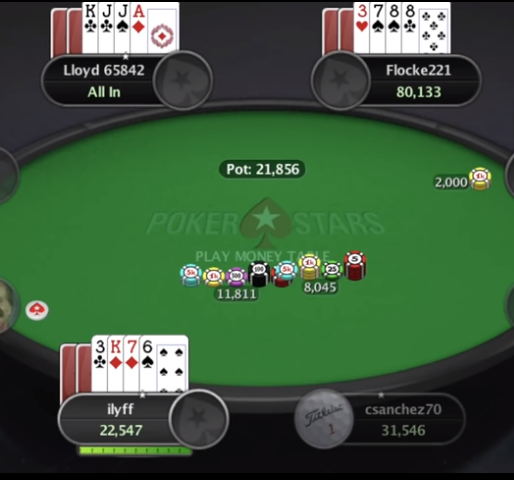Stud Strategy – Fifth Street Play

We’ve been delving deep into Seven Card Stud strategy the last few weeks and we’ve finally come to the street where you’ll make your most important decisions – Fifth Street. On Fifth Street, this is where you’re going to either commit to your hand or get out.
Today we will go over what to look for on Fifth Street and give you some tips on making the best decisions on the most critical street in Stud Poker.
Placing Your Opponent on a Hand
On Fifth Street, you should now have a good idea of where your opponent is at in a hand. You now know three of their board cards along with all of the other upcards and any folded carded from other opponents.
You should be able to reasonably guess the range of hands they may have, what they are going for, and where you stand in the hand. In some cases, this will be simple. If a player has a pair showing by Fifth Street, they likely have no worse than two pair.
If a player is showing two to three cards straight or flush cards, you can reasonably put them on a draw, especially if you know that their outs are live.
Know which outs are live will also be helpful in future streets as you can further narrow down whether the player is truly drawing, has missed their draw, or if they are merely representing a made hand.

Have You Improved?
By Fifth Street, in most cases, you need to have improved your hand in order to continue on. If you started with a three straight or flush and failed to improve to a straight or flush draw, then it is time to dump your hand. If you started with a hand such as buried nines and failed to improve your hand, there’s no sense in chasing down another opponent with a weak pair of nines.
Keep in mind that improvement does not necessarily mean you should stay in the hand. For example, if you started with 5-6-7 and caught a three, you have improved to a straight draw. However, you have a lower straight and you are stuck with just four outs. What if you improved to that draw and you know that two fours have been folded? You’re drawing to two outs and should dump the hand.
The same is true for pair improvement. If you started with buried eights and picked up an open pair of deuces by fifth, you have two pair, but how likely is that two pair to win? In this case, you need to evaluate your opponents and determine whether you want to gamble that they don’t improve to beat your weak hand.
Represent to Push Out Weaker Hands
Fifth Street is the place where you should look to push out weaker hands. If you’re sitting at Fifth Street with an open pair or three cards to a straight or flush, this is a good time to try and push players out.
Smart players are going to give you credit for a stronger hand, and will only continue if they think they have a better hand or a better draw. If anything, you will help to further define your opponent’s hand, which can save you bets on later streets if you’re behind.
Get Out or Play to the River
Fifth Street is important for two reasons. The first is that Fifth Street is where bets double. In a $2-$4 Stud cash game, betting from Fifth Street onward will be $4.
Next, if you decide to continue past Fifth Street, you are going to be committed to the hand until the river in most situations. Unless the was a significant lack of action in the hand, you will often have pot odds to call bets on Sixth and Seventh Street. Naturally, there are exceptions, such as a player catching open trips on Sixth.
At Fifth Street, you need to decide whether you’re ready to commit to the hand. If you’re on the fence, side with folding. By Fifth, you should know where you’re at in the hand. Don’t play based on feelings, but rather on the knowledge you’ve gained to this point. It’s an all or nothing proposition in most cases. You continue to the end, or you fold.
Next week, we will look at Sixth Street play. Decisions become easier as you hit the home stretch and this is the street where you can make or save the most bets in Stud poker.
